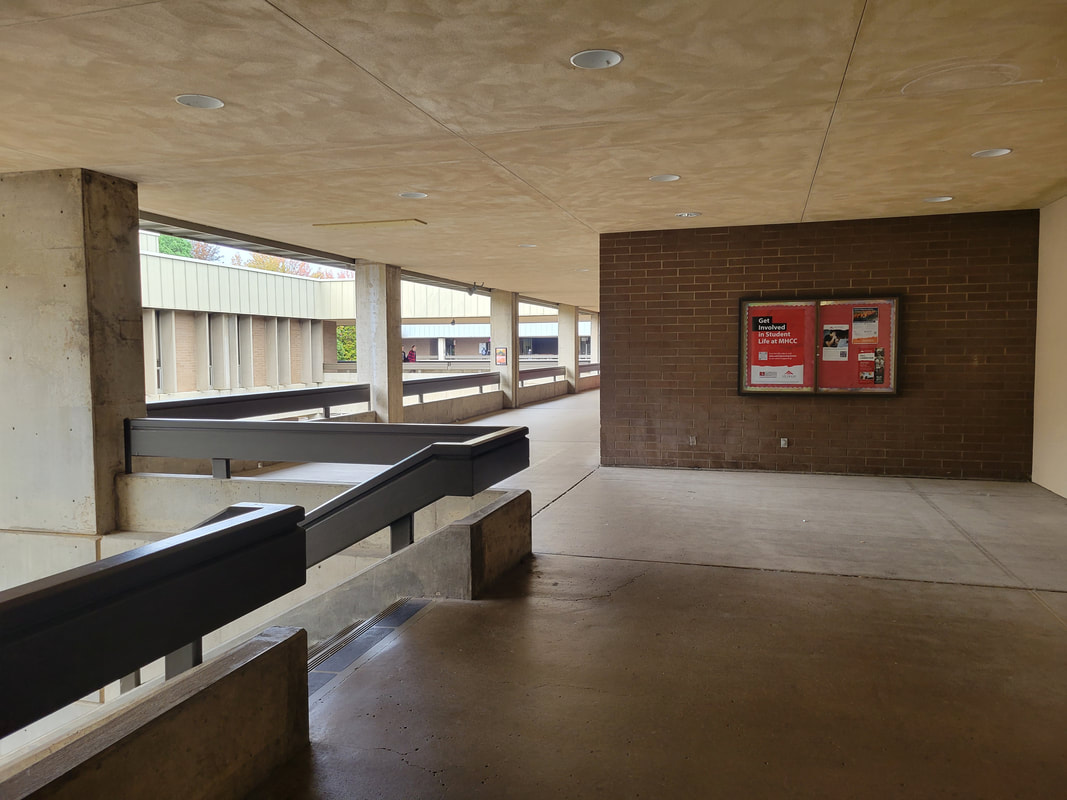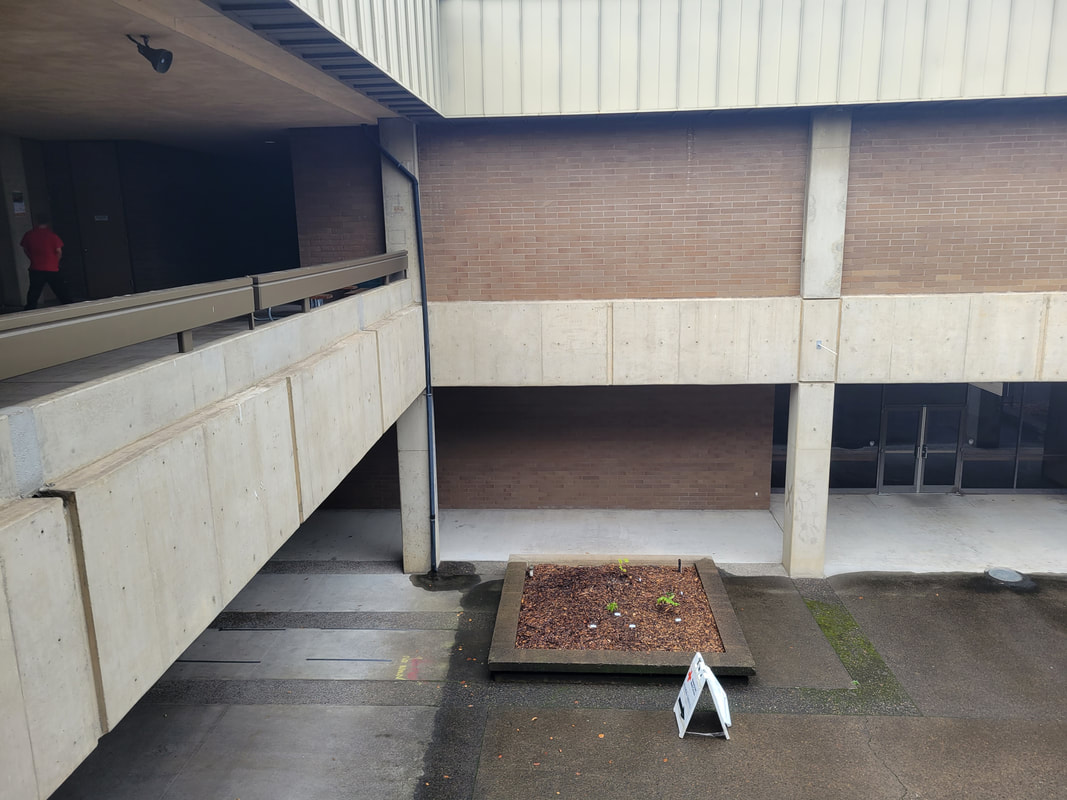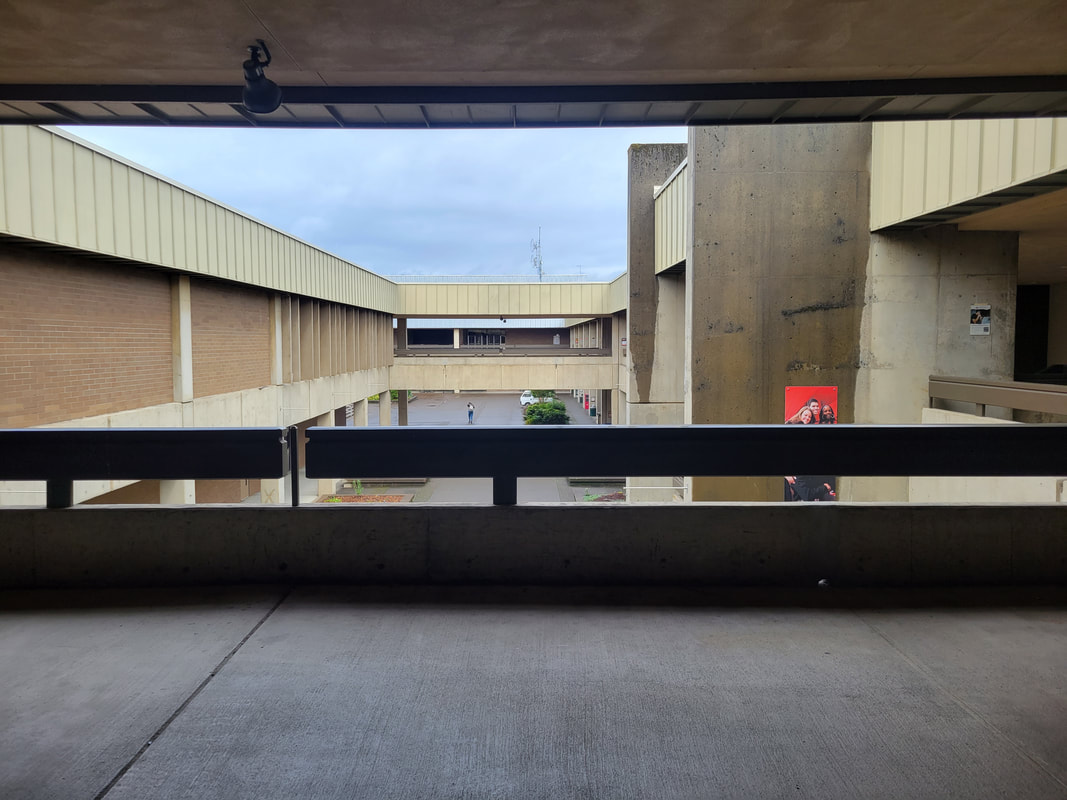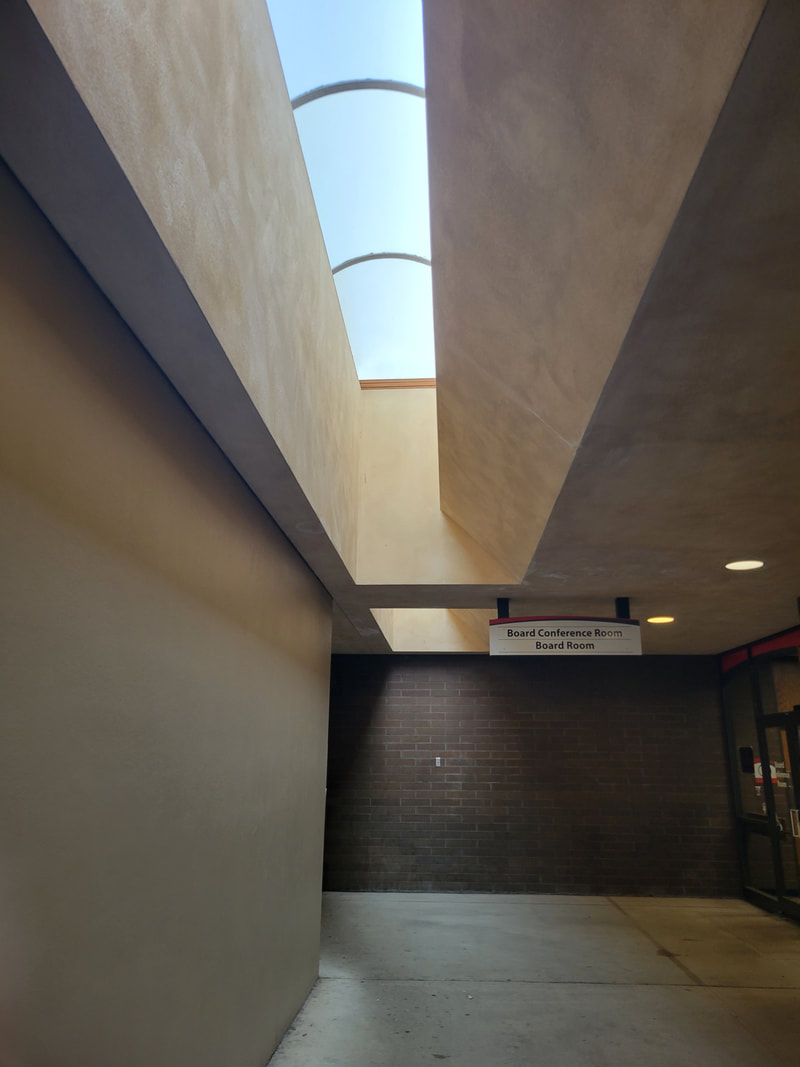Today I contemplate Brutalist architecture, the Brutalist design philosophy, and how it might be expressed in thread. The photos in this post are all my own, of Mt. Hood Community College in Gresham, Oregon, USA. DEFINING BRUTALISMThough "Brutalism" has the English word "brutal" in it, that's a false cognate. The true etymolgy is Swedish "nybrutalism" ("new brutalism") and French "béton brut" ("raw concrete"). So the word refers to raw-ness, not animalism or violence. The style followed Modernism and WWII, and really took off in the UK in the 1950s, when austerity, combined with aging Victorian tenements, meant that people needed new apartment complexes and civic buildings built quickly. It was very influencial in Communist countries in Europe (with an odd bit of cultural export by the Russians to Vietnam!), and can be seen as the mother of paneláky buildings (made of pre-fabbed concrete panels) found in Czechoslovakia. It also had its moment: from the 1950's through the 70's, with popularity waning since then. Unlike vernacular architecture, which rises organically from local needs and people, Brutalism was a designer's game. It had a clearly defined socialist philosophy: monuments for the people, made without the frills or furbellows of bygone mansions. It strove to be straightforward: concrete looked like concrete; wood like wood; I-beams like I-beams. British architects Peter and Alison Smithson waxed poetic about its purpose to "drag a rough poetry out of the confused and powerful forces" in postwar Britain. Mark Bittoni of Bittoni Architects, a modern lover of the style, is equally fulsom, being fond of the phrase "honest expression of materials" to describe the use of unadorned concrete and metal. The Brutalist school of design is divisive, a love-it-or-hate-it affair. Typically, the lovers point to the finest exemplars and the haters to the worst, to justify their positions. You can do an image search for "Brutalist architecture" to see many examples at once, and note the following elements:
The philosophy behind Brutalist architecture is rooted in the belief that architectural design should prioritize functionality, honesty, and social purpose. The style often seeks to showcase the raw beauty of materials, such as concrete, while emphasizing structural elements. The perceived ‘darkness’ or ‘coldness’ of Brutalist buildings is often a result of the honest expression of materials and a deliberate rejection of decorative elements, reflecting the design's focus on functionality and the socio-political context of its time. MT. HOOD COMMUNITY COLLEGEI have had occassion to be at this college recently, and find it very ugly. It is a perfect example of Brutalist architecture, though! Look for the features from above:
The outdoor "hallways", which run along both spine and arms, under roofs but open to the elements, are a bewildering mix of clever lighting and gloom. The skylights bring in natural light, but nothing inside the space amplifies or distributes that light, so they still need pot-lights in the ceiling. Exposed Structure - Throughout the building, there are exposed columns, exposed joints and fasteners connecting staircases to the concrete, and so on. SEWING BRUTALISM?When it comes to sewing, how might these Brutalist principles be expressed? Has it been done before? Let me think of some examples, putting the Brutalist ideals in bold, where they turn up. The Mao suit (or Zhongshan suit) first springs to mind, based on my superficial judgement that it looks drab and utilitarian. But when I research more, I find the design of the suit does align with Brutalist ideals: it's not modular in function, but it is modular in symbolism, with meaning behind the number of pockets and buttons. It is certainly unadorned. It has some exposed structure: namely that the internal pockets of Western business suites were turned into external patch pockets on the Chinese jacket. And it tends to be monochrome or drab colors (gray, navy blue, and olive green). Finally, like Brutalist architecture, it was designed by a person with an ideology, not developed over time by common folk, and it is part of a larger socio-political moment where item was meant to be used by the working-class masses. Quilting, my current art passion, is decorative by default, so it's harder to imagine a Brutalist quilt. But I think rag quilts might come close: they are sewn with their seam allowances exposed and lightly fringed, so that the first time they get washed, the edges fray and frizz up, and after that they don't unravel any more. To me, this seems to express the Brutalist ideals of letting the materials be true to themselves and exposed structure. Whole-cloth quilts might be more Brutalist than piecework, but then they'd have to be quilted in a non-ornamental manner, as well. If someone made a quilt by layering two bedsheets with a poly-fleece blanket for batting, and used big-stitch quilting, and didn't bind the edges, that might be a Brutalist quilt. I would probably hate it, though! Works Cited[Some webpages are not in English, so I relied on Google Chrome's translation tool to get their gist.] Bittoni, Mark, quoted by McLaughlin, K. (2023, July 12). Brutalist architecture: Everything you need to know.
Architectural Digest. https://www.architecturaldigest.com/story/brutalist-architecture-101. Accessed 25 October 2023. Lipták, M., & Pindel, T. (2016). Vše o panelových domech. PANELAKY.INFO. https://panelaky.info/ Mack, L. (2019, July 3). The history behind the Chinese version of a business suit. ThoughtCo. https://www.thoughtco.com/chinese-clothing-mao-suit-687372. Accessed 4 November 2023. Smithson, Alison and Peter (April 1957). "The New Brutalism". Architectural Design. Quote found via wikipedia, https://en.wikipedia.org/wiki/Alison_and_Peter_Smithson#cite_note-11. Accessed 25 October 2023. Vũ, Hiệp (19 October 2021). "Isakovich và sự biến đổi kiến trúc Liên Xô ở Việt Nam" [Isakovich and the evolution of Soviet architecture in Vietnam]. Tạp chí Sông Hương. http://tapchisonghuong.com.vn/tap-chi/c455/n30813/Isakovich-va-su-bien-doi-kien-truc-Lien-Xo- o-Viet-Nam.html. Accessed 25 October 2023.
0 Comments
Leave a Reply. |
Karen Roy
Quilting, dressmaking, and history plied with the needle... Sites I EnjoyThe Quilt Index Categories
All
Archives
March 2024
|






 RSS Feed
RSS Feed